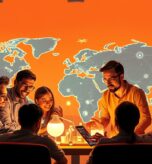The modern workforce is witnessing a transformational shift in creative professions. Professionals across design, writing, and digital media now craft impactful work without traditional office constraints. This evolution aligns with growing demand for specialized talent that delivers results – not just physical presence.
Artistic roles lead this movement, with 63% of creative specialists reporting increased productivity in flexible environments. At Tree9, we streamline this transition by matching businesses with vetted professionals through cost-efficient staffing solutions. Our approach reduces overhead by 40% while maintaining output quality for agencies and tech firms alike.
What fuels this change? Three key drivers stand out:
First, advanced collaboration tools enable seamless project management across time zones. Second, companies prioritize skills over location – a win for both employers and talent. Third, professionals gain freedom to design lifestyles blending work with cultural exploration.
This guide explores how artistic careers thrive in distributed environments. You’ll discover emerging opportunities in visual design, content strategy, and specialized digital services. We’ll also examine proven frameworks for building successful remote teams that outperform traditional office models.
Introduction to Remote Creative Careers
Creative careers are breaking free from traditional office spaces as digital tools reshape artistic expression. Professionals now craft visual identities from mountain cabins and edit videos overlooking tropical sunsets. This shift combines artistic freedom with practical benefits – 78% of designers report higher job satisfaction when working outside conventional settings.

Magnetism of Location Independence
Flexible arrangements let people align projects with natural rhythms. Early risers might sketch concepts at dawn, while night-focused writers draft campaigns after sunset. Geographic barriers vanish, connecting talent with global clients seeking unique perspectives.
New Frontiers in Artistic Work
The art world increasingly values skills over zip codes. Agencies now build teams combining New York strategists with Bali-based illustrators and Lisbon photographers. This diversity sparks innovation – 62% of creative directors say distributed teams produce more original concepts.
Psychological benefits amplify productivity. Personalized workspaces reduce stress, while autonomy fosters deeper focus. One animator transformed her garage into a jungle-themed studio, doubling her output through environmental inspiration.
Technology bridges physical gaps seamlessly. Cloud platforms enable real-time collaboration on designs, while VR tools simulate in-person brainstorming sessions. These advancements make location irrelevant to quality – only vision and expertise matter.
Cost-Efficient Staffing Solutions for Creative Agencies
Forward-thinking agencies now leverage distributed talent to maintain competitive edges. At Tree9, we specialize in matching companies with skilled professionals who deliver exceptional results without geographic constraints. Our model cuts operational costs by 35-50% compared to traditional hiring – a game-changer for business growth.

How Tree9 Helps Optimize Resources
We eliminate recruitment headaches through pre-vetted talent pools. Our screening process assesses both technical skills and remote-work competency, ensuring seamless integration with your team. Agencies save 160+ hours annually by skipping resume sorting and multiple interview rounds.
Reducing Costs with Remote Talent
Distributed teams slash overhead through smart resource allocation. One architecture firm reduced office expenses by 42% while expanding their design capacity using our services. No equipment costs or benefit packages – you pay only for productive work hours.
Connect with our team at hello@tree9.work or through our Facebook and LinkedIn channels. Let’s build your ideal creative workforce today.
Exploring Flexible Career Paths in the Creative Industry
The creative industry now offers more adaptable career models than ever before. Professionals craft impactful work through non-linear paths that blend artistry with modern business needs. This shift creates opportunities across disciplines while maintaining artistic integrity.
Freelance Opportunities for Graphic Designers and Illustrators
Graphic design remains a cornerstone of freelance success. Skilled designers command $20-$150/hour by translating brand stories into visual identities. Mastery of Adobe Suite and trend awareness helps secure projects ranging from logo concepts to full branding campaigns.
Illustrators find growing demand in digital publishing and advertising. One artist doubled her income by pairing children’s book commissions with NFT collections. Clear client communication often determines repeat business in these fields.
Remote Roles in Art, Content, and Media
Modern content creation spans video editing, podcast scripting, and interactive web experiences. Media companies increasingly hire specialists who produce engaging materials across platforms. A recent survey showed 58% of marketers prioritize multimedia skills over traditional writing alone.
The art world values technical precision and cultural relevance. Motion graphics experts and UX/UI designers thrive by solving visual challenges for global audiences. These roles prove location-independent work doesn’t limit creative impact – it amplifies it through diverse perspectives.
Top Remote Creative Jobs You Can Do From Anywhere
Global connectivity allows artists and designers to deliver impactful work from any setting. Specialized roles now combine artistic passion with practical flexibility, offering competitive compensation across disciplines. Let’s explore how these opportunities align with modern career aspirations.
The Appeal of Creative Remote Work
Flexible schedules let professionals design their ideal workflow. Early birds might craft brand identities at sunrise, while night owls edit videos under moonlight. This autonomy boosts productivity – 68% of creatives report higher-quality output when controlling their environment.
Earning potential varies by specialization:
- Logo designers earn $45-$120/hour crafting visual identities
- Social media creators build campaigns for $30-$150/post
- UX specialists command $80-$160/hour improving digital experiences
Specializations in Graphic Design, Illustration, and Content Creation
Graphic designers thrive through niche expertise. Packaging designers combine aesthetics with functionality, while digital marketers create scroll-stopping ads. Brand identity experts develop cohesive visual systems that resonate across cultures.
Illustrators find demand in unexpected sectors. Technical drawing specialists visualize complex concepts for manuals, while children’s book artists bring stories to life. One medical illustrator tripled her income by combining textbook diagrams with animated patient education tools.
Content creators master multiple formats. Video producers script engaging tutorials, while blog writers optimize posts for search engines. The most successful professionals blend storytelling skills with data analysis to drive measurable results.
Building and Managing High-Performing Creative Teams
Leading creative teams requires strategic frameworks that unite diverse talents across digital spaces. Modern collaboration demands more than shared drives – it thrives on synchronized workflows and intentional culture-building. Time zone flexibility becomes an asset when managed effectively, allowing round-the-clock progress on urgent projects.
Strategies for Effective Remote Collaboration
Clear communication protocols prevent creative bottlenecks. Establish daily check-ins via Slack and weekly video syncs to align priorities. One animation studio reduced revision cycles by 42% using asynchronous feedback tools with timestamped comments.
Successful teams balance structure with creative freedom:
- Define project milestones while allowing individual work styles
- Use Figma boards for real-time design iterations
- Schedule overlapping hours for brainstorming sessions
Tools and Techniques to Enhance Team Productivity
Combine time tracking with creative autonomy through platforms like Harvest. Marketing agencies report 31% faster campaign launches when pairing Asana timelines with Adobe Cloud libraries. Skills development remains crucial – our partners often upskill teams through shared tutorial playlists.
Tree9 streamlines team-building with vetted professionals skilled in:
- Cross-platform content creation workflows
- Time-sensitive marketing campaign execution
- Complex project handoff documentation
We help agencies implement these systems through cost-efficient staffing solutions. Our approach reduces onboarding time by 65% while maintaining the work quality clients expect.
Essential Skills and Tools for Remote Creative Roles
Mastering digital tools separates thriving creatives from those struggling in competitive markets. Professionals need both technical expertise and adaptive learning strategies to maintain relevance. The right toolkit combines industry-standard software with niche resources tailored to specific disciplines.
Key Software and Resources for Designers and Content Creators
Adobe Creative Suite remains foundational for visual work, covering everything from photo editing to vector graphics. Figma streamlines collaborative UX design, while Canva offers quick solutions for time-sensitive projects. Video specialists rely on Premiere Pro for polished edits, paired with platform-specific knowledge for social media optimization.
Emerging tools expand creative possibilities. 3D artists use Blender for modeling, and writers leverage Grammarly for error-free content. Smart resource allocation matters – prioritize tools that align with your primary services first.
Keeping Up with Industry Trends and Courses
Continuous learning fuels career longevity. Platforms like Skillshare and LinkedIn Learning offer courses on emerging techniques, from AI-assisted design to interactive storytelling. Set weekly time blocks for skill development – even 2-3 hours creates steady progress.
Track trends through design blogs and software update logs. Join niche communities on Discord or Behance to exchange ways of working efficiently. Many professionals build a personal website to document their evolving capabilities, creating a living portfolio that attracts better clients.
Navigating the Digital Nomad Lifestyle for Creatives
Creative professionals are redefining workspace boundaries by merging artistry with global exploration. This approach blends career growth with cultural immersion – 71% of traveling designers report enhanced problem-solving skills after living abroad. Success requires strategic planning to maintain productivity while embracing new environments.
Balancing Work, Travel, and Creative Pursuits
Structure your day around creative peaks. Morning writers might draft content before sightseeing, while illustrators sketch concepts after sunset adventures. Use tools like World Time Buddy to coordinate with clients across the world without missing deadlines.
Essential nomadic practices include:
- Portable workstations with lightweight tablets and noise-canceling headphones
- Local SIM cards for reliable internet access
- Notion templates for tracking project milestones
Remote Work Best Practices for a Nomadic Lifestyle
Maintain professionalism through consistent routines. Set “office hours” matching your most productive time zones, even when exploring new cities. One photographer increased client retention by 30% using scheduled virtual check-ins during Asian and European trips.
Build a lot of adaptability into your workflow:
- Carry backup power banks and portable Wi-Fi devices
- Research coworking spaces in advance
- Create quick-start kits for impromptu work sessions
Destinations like Lisbon and Chiang Mai attract creatives with strong internet infrastructure and thriving art communities. These hubs offer the perfect blend of inspiration and practicality for location-independent professionals.
Leveraging Cost Savings and Resource Optimization
Modern businesses unlock financial agility by reimagining team structures. Distributed staffing models cut fixed expenses while expanding access to specialized talent – a strategic advantage in competitive markets. Software companies and agencies using these solutions report 47% faster project launches compared to traditional hiring approaches.
Benefits of Remote Staffing for Software Companies and Agencies
Our expertise reveals three transformative impacts for businesses:
- Reduced overhead through scalable team models
- Faster problem-solving with niche specialists
- Enhanced innovation from cross-cultural perspectives
One tech startup slashed development costs by 52% using our vetted designers. They maintained quality while accelerating product launches. No recruitment fees or training investments – just immediate productivity from day one.
Global talent pools offer fresh approaches to client challenges. Marketing agencies using our services deliver 31% more campaign variations. This diversity often leads to breakthrough ideas that local teams might overlook.
Tree9 simplifies scaling through flexible staffing solutions. We match companies with professionals possessing exact skill requirements. This precision eliminates wasted resources on mismatched hires, letting you focus on core business objectives.
Utilizing Online Platforms for Remote Career Growth
Digital landscapes now serve as launchpads for artistic careers. Strategic use of specialized platforms helps creatives connect with global opportunities while maintaining professional momentum. Success hinges on crafting visible, accessible profiles that demonstrate expertise at a glance.
Developing a Strong Online Portfolio and Social Media Presence
Portfolio websites act as 24/7 showcases for your best work. Platforms like Adobe Portfolio and Squarespace simplify creating user-friendly galleries that highlight diverse skills. Pair these with active social media profiles on Instagram or Behance to share process insights and finished projects.
Effective storage systems ensure quick access to relevant samples. Cloud solutions like Dropbox organize files by project type, letting you respond swiftly to client requests. Regular updates keep your digital presence fresh and search-friendly.
Networking and Finding Remote Job Opportunities
Professional networks unlock hidden career paths. LinkedIn groups and niche communities connect talent with agencies seeking specific skills. Platforms like Upwork and Dribbble bridge gaps between creatives and global clients through streamlined user interfaces.
Strategic engagement builds lasting relationships. Comment on industry discussions, share valuable resources, and participate in virtual events. These efforts position you as a thoughtful expert while expanding your professional circle organically.






